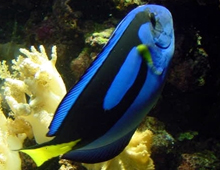Description: The Blue hippo tang is also known as the Palette or Hepatus tang. The depressed body is a vibrant blue with contrasting bold, black markings. The black markings begin at the eyes, goes along the dorsal line down to the tail and circles back above the pectoral fin. The unique pattern these lines create resembles a painter’s palette, thus giving it one of its common names. The caudal fin is yellow with a black stripe along the upper and lower portion of the fin. It has a pointed snout-like nose. Like other members of the surgeonfish family, it is armed with sharp spines at the base of its tail. This species, however, has an added weapon in the fact that the spines are armed with a venom gland, which can inflict a bee-like sting to its victim.
Size: It reaches a length of about I2 inches (30.5 cm).
Behavior: They live in pairs or in small groups. They are active during the day and when frightened, they hide within the coral. Blue hippo tangs have the ability to make themselves semi- transparent in order to evade predators.
Diet: They are omnivores, feeding on plankton and algae. However, as juveniles they primarily eat plankton.
Reproduction: The male and female swim quickly upward releasing their eggs and sperm into the water column; fertilization is external. The pelagic eggs are small and contain a single droplet of oil that aids in flotation. Twenty-four hours later, the fertilized eggs hatch, revealing small translucent larvae.
Habitat/range: Blue hippo tangs are native to reefs throughout the Indo-Pacific region.
Status: They are listed as Least Concern on IUCN Red List.



